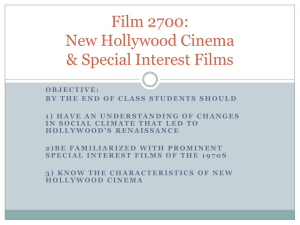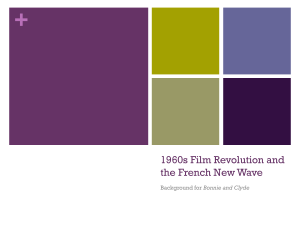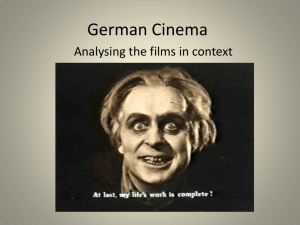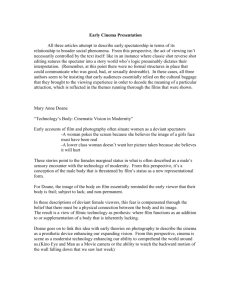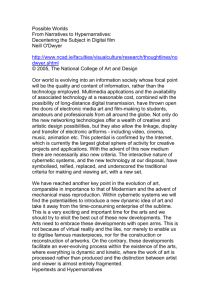Weimar Cinema Revision 1
advertisement
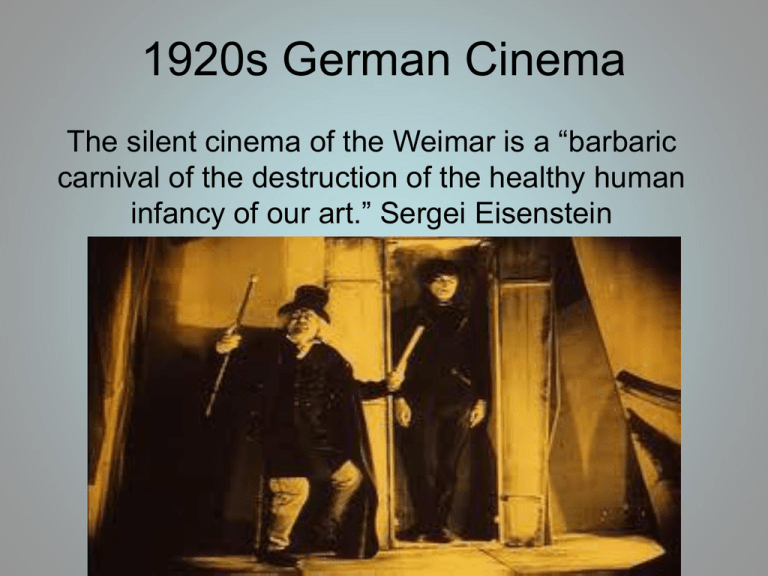
1920s German Cinema The silent cinema of the Weimar is a “barbaric carnival of the destruction of the healthy human infancy of our art.” Sergei Eisenstein Key study films • The Cabinet of Dr Caligari • Nosferatu • Metropolis Honourable mentions: • • • • • • The Golem Dr Mabuse, the Gambler The Last Laugh Faust The Niebelungen Pandora’s Box What issues of context affected the films we have studied? Germany – the ‘negative’ influences on Weimar Cinema • Post –war economic depression • The new liberal Weimar republic unable to keep stability because of political tensions between right-wing (fascist) & left-wing (communist) activists • Fresh memories of wartime horror led to an interest in ‘mystical arts’ (the occult, astrology, etc) • Sense of escapism to a pre-industrial past • Anti-Semitism on the rise Germany – the ‘positive’ influences on Weimar Cinema • 1920s Berlin was a time of artistic and cultural experimentation – art, music, architecture & film flourished • The hyper-inflation that destroyed middle-class savings in the early twenties was over by the 2nd half of the decade • UFA studios realised that the experimentalism in German cinema gave the films a selling point to the rest of the world • Interest in the new psychoanalysis The influence of expressionism • George Grosz- The Lovesick Man (1916) What strikes you as being characteristically expressionistic about the image? Key features of Expressionism: • • • • • • • Art was to express emotions Expressionist artist used strong emotional colours and wild brush strokes. The stressed irrationality of the world, the natural and the social world The world of the supernatural was a strong influence, of ghosts, magic, monsters, strange things happening, to mythic tales, etc. Individual alienation from the natural world and from the social world — The individual does not feel like they belong in either the social world or the natural world. That they are alone and abandoned. The impact of industrial, capitalist society on human beings. Weimar Cinema & Expressionism Remember, not all German film from this period was ‘expressionistic’. Arguably, The Cabinet of Dr Caligari is the only ‘truly’ expressionistic film. Fritz Lang, for instance distances himself & even has Dr Mabuse reflect on expressionistic art as ‘a game’. However, The specific influences of Expressionism on the films are: 1.The influence of Expressionist painting can be seen in the way the film set was painted and built. 2.There is a strong use of darkness and light, especially of shadow. 3.There is also use of strange angles in making Expressionist cinema, strange camera perspectives. 4.The story is sometimes taken from Gothic myth, the 14th century, e.g., Caligari, Dracula, ghosts. 5.The supernatural has a very strong place in the film. 6.There is the appearance of irrationality, in the world, in the people, and in the story. 7.Emotions are strongly expressed. 8.The film and the world appear to be insane. 9.An insane world is not a place where there is a happy ending. How is insanity depicted in the films? Why? How is death depicted in the films? Why? Film form What can you say about: • • • • • Mise-en-scene? Performance? Lighting? Cinematography? Editing? Portrayal of women Critical Approaches Siegfried Kracauer: foreshadowing the rise of Hitler Evidence to support these key arguments? • Popular cinema reflected a German desire for stability, even if it meant giving up to a tyrant figure • Hypnotism and control are key ideas that recur throughout the films • Chaos threatens stability Critical Approaches Anton Kaes: Shellshock Cinema • The films reflect an unspoken war trauma • Evidence? The Exam Paper Do NOT answer questions 1 or 2 on Aspects of a National Cinema Do answer question 3 or 4 on International Film Styles • Your answer should be based on a minimum of two films and should be based on one of the following: • German and/or Soviet Cinema of the 1920s, Neo-Realism, Surrealism, New Waves Q.3 To what extent has your chosen international style developed out of a response to a particular set of factors at a particular moment in history? • Level 4 • A sound appreciation of the films studied in terms of their historical moment of production / reception • A detailed and sophisticated knowledge and understanding of the films in themselves and in relation to the international film style which they represent • An ability to develop an answer to the question based on the above, using detailed and appropriate examples. • (The very best candidates) … will either demonstrate a particularly high order of knowledge, understanding and appreciation of historical contextual factor or offer a convincing argument against the proposition. Q.4 Discuss the distinctive contribution made to your international style by the use of either editing or cinematography or sound. Level 4 • A sound appreciation of the films studied with an ability to make detailed and close reference to either editing or cinematography or sound in the chosen films • A detailed and sophisticated knowledge and understanding of distinctive aspects of the film style / movement within which the films are located • An ability to develop a discussion based on the above, using detailed and appropriate examples. • (The very best candidates) … will demonstrate a particularly high order of knowledge, understanding and appreciation of either editing or cinematography or sound in their chosen films and the international style they represent.

